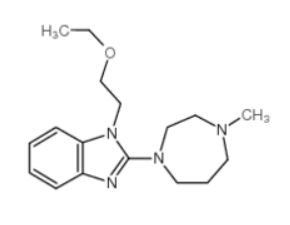
Emedastine
CAS No. 87233-61-2
Emedastine( —— )
Catalog No. M19204 CAS No. 87233-61-2
Emedastine is a second generation, selective histamine H1 receptor antagonist with anti-allergic activity.
Purity : >98% (HPLC)
 COA
COA
 Datasheet
Datasheet
 HNMR
HNMR
 HPLC
HPLC
 MSDS
MSDS
 Handing Instructions
Handing Instructions
| Size | Price / USD | Stock | Quantity |
| 5MG | 65 | In Stock |


|
| 10MG | 105 | In Stock |


|
| 25MG | 177 | In Stock |


|
| 50MG | 264 | In Stock |


|
| 100MG | 393 | In Stock |


|
| 500MG | 884 | In Stock |


|
| 1G | Get Quote | In Stock |


|
Biological Information
-
Product NameEmedastine
-
NoteResearch use only, not for human use.
-
Brief DescriptionEmedastine is a second generation, selective histamine H1 receptor antagonist with anti-allergic activity.
-
DescriptionEmedastine is a second generation, selective histamine H1 receptor antagonist with anti-allergic activity. Emedastine reversibly and competitively blocks histamine by binding to H1 receptors, thus blocking its downstream activity. As a result this agent interferes with mediator release from mast cells either by inhibiting calcium ion influx across mast cell/basophil plasma membrane or by inhibiting intracellular calcium ion release within the cells. In addition, emedastine may also inhibit the late-phase allergic reaction mediated through leukotrienes or prostaglandins, or by producing an anti-platelet activating factor effect. Upon ocular administration, emedastine causes a dose-dependent inhibition of histamine-stimulated vascular permeability in the conjunctiva. Emedastine does not affect adrenergic, dopamine, or serotonin receptors.(In Vitro):Emedastine inhibits histamine H2 receptor (Ki=49067 nM) and histamine H3 receptor (Ki=12430 nM).High concentrations of Emedastine (1 and 10 ng/ml) significantly inhibits type 1 collagen production in normal human dermalfibroblasts.Emedastine (1, 10, 100, 1000 nM) at concentrations of ≥ 10 nM inhibits CC chemokine-elicited eosinophil migration.(In Vivo):Emedastine (0.03, 0.1, 0.3 mg/kg; orally; pretreatment of 30 min) significantly suppresses histamine-induced scratching with 0.1 and 0.3 mg/kg but not 0.03 mg/kg.Pretreatment with Emedastine (0.03, 0.1, 0.3 mg/kg; orally) significantly inhibits the scratching induced by substance P and leukotriene B.Emedastine (0.3 mg/kg, p.o.) produces significant inhibition of passive peritoneal anaphylaxis in guinea-pigs.Emedastine inhibits histamine-induced contractions of isolated ileum (IC50=6.1 nM).
-
In VitroEmedastine inhibits histamine H2 receptor (Ki=49067 nM) and histamine H3 receptor (Ki=12430 nM).High concentrations of Emedastine (1 and 10 ng/ml) significantly inhibits type 1 collagen production in normal human dermal fibroblasts.Emedastine (1, 10, 100, 1000 nM) at concentrations of ≥ 10 nM inhibits CC chemokine-elicited eosinophil migration.
-
In VivoEmedastine (0.03, 0.1, 0.3 mg/kg; orally; pretreatment of 30 min) significantly suppresses histamine-induced scratching with 0.1 and 0.3 mg/kg but not 0.03 mg/kg. Pretreatment with Emedastine (0.03, 0.1, 0.3 mg/kg; orally) significantly inhibits the scratching induced by substance P and leukotriene B. Emedastine (0.3 mg/kg, p.o.) produces significant inhibition of passive peritoneal anaphylaxis in guinea-pigs. Emedastine inhibits histamine-induced contractions of isolated ileum (IC50=6.1 nM). Animal Model:Male ICR mice 5-6 weeks of age Dosage:0.03, 0.1, 0.3 mg/kg Administration:Orally; 30 min before pruritogen injection Result:Significantly suppressed histamine-induced scratching with pretreatment of 0.1 and 0.3 mg/kg.
-
Synonyms——
-
PathwayOthers
-
TargetOther Targets
-
RecptorH1 receptor
-
Research Area——
-
Indication——
Chemical Information
-
CAS Number87233-61-2
-
Formula Weight302.42
-
Molecular FormulaC17H26N4O
-
Purity>98% (HPLC)
-
SolubilityIn Vitro:?DMSO : 125 mg/mL (413.35 mM)
-
SMILESCCOCCn1c2ccccc2nc1N1CCCN(CC1)C
-
Chemical Name——
Shipping & Storage Information
-
Storage(-20℃)
-
ShippingWith Ice Pack
-
Stability≥ 2 years
Reference
molnova catalog



related products
-
Peonidin-3,5-O-diglu...
Peonidin-3,5-O-diglucoside chloride is a natural product.
-
3,5-Dimethoxytoluene
3,5-Dimethoxytoluene (Orcinol dimethyl ether), the main fragrance component in roses, has a sedative effect and can be used as a pest attractant.
-
Kinase Domain of Ins...
Kinase Domain of Insulin Receptor (1)



 Cart
Cart
 sales@molnova.com
sales@molnova.com


